It wasn’t long ago that I spend three days along the California Central Coast, scouting good shooting locations for the upcoming Central Coast and Napa Valley workshop. I’m very familiar with the Big Sur coast but this was my first real exposure to the Central Coast north of San Francisco. And I am excited with what I found.
My base of operations was the Schoolhouse Canyon Campground, a privately owned campground just east of Guerneville on the Russian River. Clean, quite – I couldn’t have been more pleased. But on with the photography….
The plan was to start to the north and work south over the next three day’s. I was joined by a friend the first day which started out overcast and foggy along the coast. That’s not a huge surprise as this area is still susceptible to the marine layer in September. But, in this line of business, you work with what you got. The first destination was Salt Point. It’s hard to find because there are no marked turn-offs, just a sign saying you’re entering and another sign a few miles up the road saying you’re leaving. So we overshot it. And I’m glad we did because we came upon a creepy house that was falling apart.
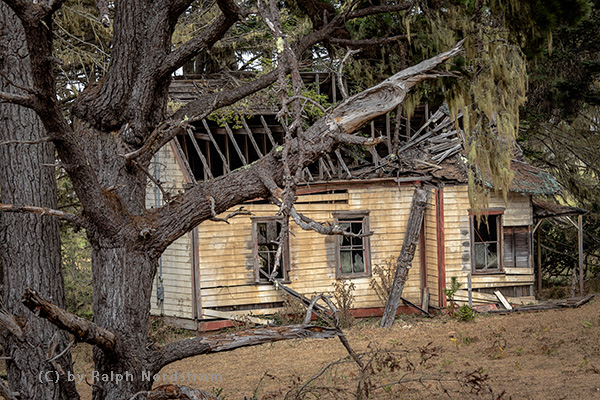
My friend suggested framing the house with moss hanging from the tree. That was the perfect touch to give it the macabre feeling we were feeling, And the overcast sky provided the perfect light.
Backtracking to Salt Point, we pulled over at the first turn-out after the ‘Entering Salt Point…” sign. We were a good quarter-mile inland but a trail led across a grassland expanse to what appeared to be promising, So we hefted our camera bags and set out. The expanse was wide open but framed on either side by jack pines, many of whom were dead. But in the middle was a lone tree that called to me. I found the two the compositions below. Which one do you like the best? (I have my favorite which shall remain a secret.)
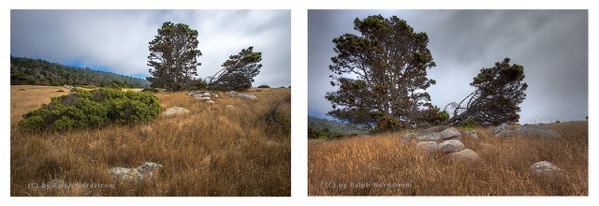
In both compositions I wanted to make use of the rocks and shrubs to lead into the image. The photographs were taken as I approached the tree. It’s interesting how a composition can unfold as you explore the subject.
When we reached the coast we were on the top of a bluff looking down on the surf below. The bluff consisted mostly of sandstone with other varieties of sedimentary rocks. The rocks were sculpted by the sea, wind and rain and formed fascinating shapes and patterns. The point that makes up the state park is quite large and we did out best to explore as much as we could.
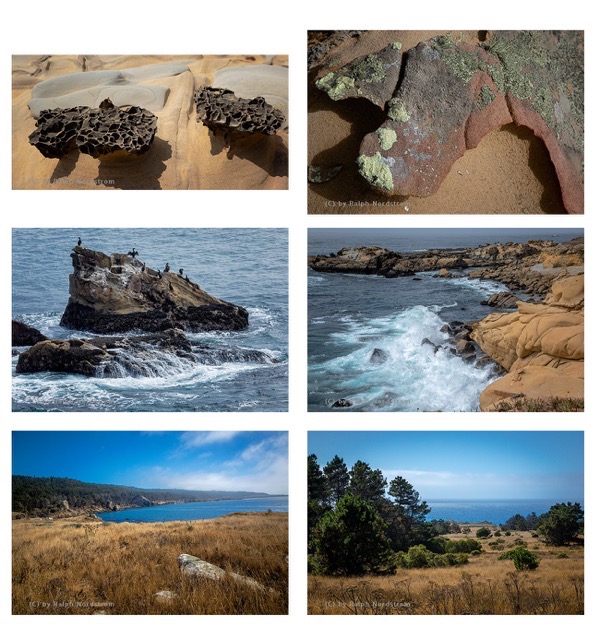
The top left image is an example a rock called tafoni, a bizarre honeycomb formation. No-one knows for sure how it is formed but is very interesting. Salt collects in the depressions which gives Salt Point its name. To it’s right is another multi-colored rock we found, covered with lichen. I played around with a number of different compositions and liked this one the best because it reminds me of my dog, Chuckie.
As we continued to explore the point, we came across a moderate sized sea stack with a flock of cormorants taking a break from fishing. And one was drying his wings. Besides just photographing the birds, which was interesting in its own right, I also wanted to get the surf draining off the foreground rock to provide a sense of the cormorants’ world. And I like the texture that the water creates. The other photograph on that row captures a wave breaking on the rocks below. Photographing the surf entails watching waves come in and trying to anticipate which ones will generate some action. When you pick one then you fire off 5 or more shot in rapid succession in hopes of capturing the best moment.
The bottom row of images give a bit of a feeling for the size of the park. The first looks down the coast and I couldn’t resist the driftwood log in the lower right corner pointing the way. The second is from the highway looking down the point. Being framed on both sides by trees, I was drawn into this image and had to bring the memory home with me.
The next location that called out to us was Stockhoff Creek. I believe by this point we’re in the Sonoma Coast State Park which consists of a whole string of beaches and points all the way down to Bodega Bay.
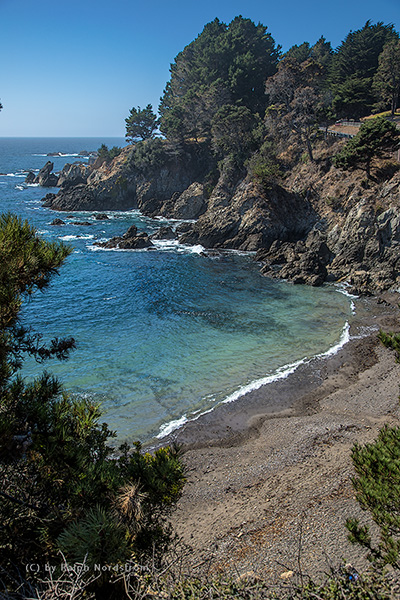
This little cove was lovely, very intimate. And the composition I liked the best was to frame it between the trees, The patterns in the beach below are interesting and the curve that starts with the beach and extends out to the tip of the point gives the image grace and a sense of motion. We are now coming into afternoon light which is casting shadows that give definition to the rocks on the bluff and point. And just look at that beautiful water.
The next stop was Fort Ross. This fort was built by the Russians back in 1812. The Russians had migrated down from the Alaska, establishing outposts as they went. They made it as far as just north of San Francisco Bay.
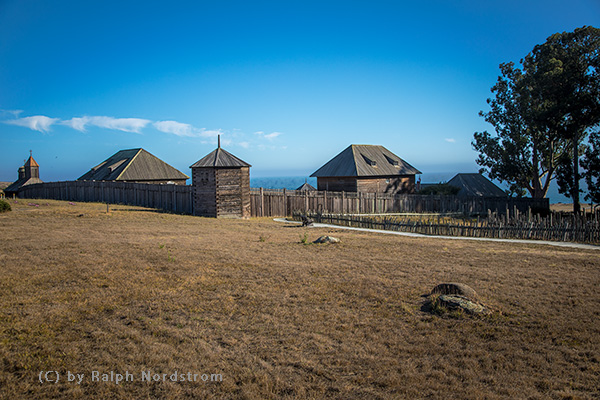
The original fort burned down a few years ago but extensive notes had been taken on the details of its construction so it could be rebuilt, maintaining its authenticity. I took a few inclusive images like the one above but the ones that stand out now are the more intimate ones, images of fascinating details.
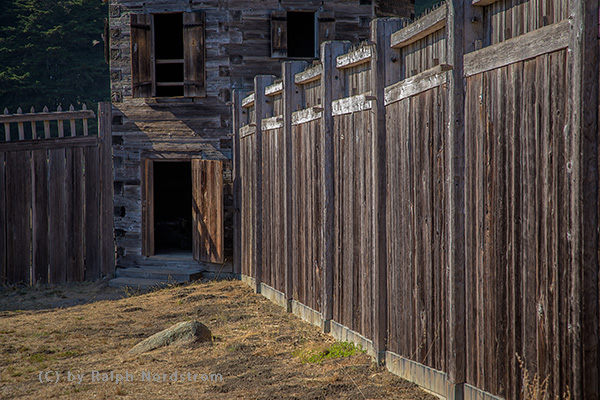
I couldn’t resist this image. The light on the wall was perfect, creating a pleasing texture. And it leads you into the ground floor door of one of the two block towers. This is one of my favorites.
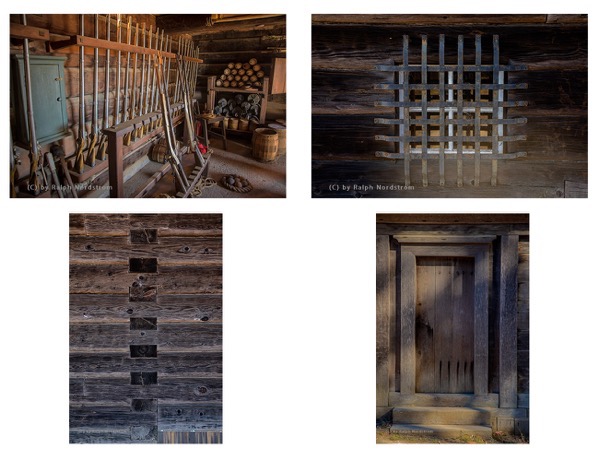
One of the buildings had a room devoted to the armory. It was very dark with just the faintest light coming in through the small window. I had to push the ISO way up to get a sharp image. But because the light is so soft and warm the result is very pleasing, regardless of the intent of the rack of rifles.
It seems that when one photographs buildings one is required to photograph windows. Windows are best photographed when they have colorful flower boxes but I’ve never really been into that. However, because it’s a given that this is what photographers do, I photographed this window. In leu of a box of geraniums, this one has the metal straps that makes one think of a brig. But the horizontal and vertical lines make for a compelling design. The other thing that photographers are virtually required to photograph is doors. So the bottom right is my homage to that necessity. It’s a very plain door and that’s why I like it so much. There is no fancy door latch or elaborate hinges, it’s just a door that is about as simple as it can be, apart from the fact that is about as sturdy as a ship’s keel.
The final image is pure abstract. It’s all horizontal lines with a vertical line right down the center. Actually, it documents the construction technique but I’d rather not think of it that way. I’d rather enjoy if as the interesting abstract that it really is.
The last stop of the day was Russian Gulch. This is a massive sea stack with a tiny arch.
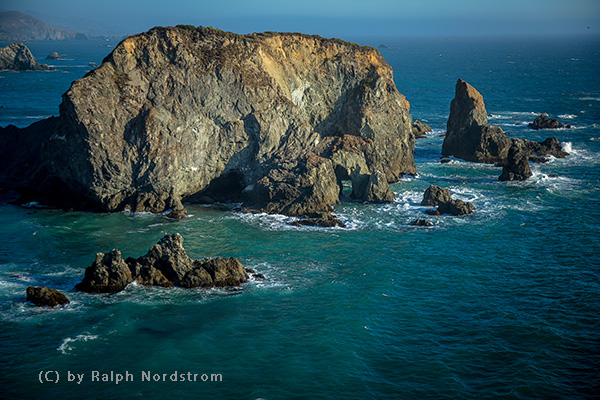
There was a little bit of wave action going on down there and an occasional big splash. But I’ve learned that what appears as a big splash to our eyes is just a little thing to the camera when it is this far away. If you want to photograph a big splash, you need to be close to it (while maintaining a safe distance). And besides, the point of the photograph is not to capture a big splash but to photograph the sea stack with the tiny arch. So rather than trying to capture dramatic moments in the sea, I found myself more interested in the aftermath with the patterns around the rocks created by the white foam.
That’s the end of what turned out to be a full and fruitful day of photography. What started out as overcast and foggy ended up with clear skies and bright sunshine. We didn’t stick around for sunset as both of us were pretty worn out. And I was going to have two more days on my own. So I headed back to camp and my friend headed home.
I’ll be returning here November 2018 with a group. Come join us and share in the adventure, Click here for more information,
(106)
